Tuesday, April 28th 2020

Intel 10th Generation Core Desktop Series Presentation Leaked
Ahead of its launch, tech publication HD Tecnologia posted the press-deck of Intel's 10th generation Core "Comet Lake-S" desktop processor series, as its launch is imminent (30th April, according to the slides). Right upfront, we see Intel's new retail packaging for the flagship Core i9 parts. Gone is the large acrylic dodecahedron, and in its place is a conventional paperboard-looking cuboidal box with a large triangular cutout window (probably made of LDPE) on the front face, which reveals the processor inside.
The next slide reveals all that's new with the 10th generation Core processor family, starting with clock speeds of up to 5.30 GHz, the desktop debut of Intel's Thermal Velocity Boost technology, HyperThreading being enabled across the board (Core i9 thru Core i3), native support for DDR4-2933, new CPU- and memory-overclocking features, and new platform I/O through the 400-series chipset. Next up, we see overclocker-relevant new features. Apparently, these processors allow you to toggle HyperThreading on a per-core basis. Until now, you could toggle HTT only across all cores. Next up, is "overclocking" for the PCI-Express x16 link (PEG) and DMI chipset bus. There are improved V/F curve controls with this generation. Intel is preparing to announce updated XTU and Performance Maximizer utilities. There are some packaging-level refinements, too, such as a physically thinner die (Z-height), making way for a thicker IHS. The internal TIM is still solder. We now move on to the actual SKUs.The slides don't reveal which specific SKUs launch on April 30, but we count 22 SKUs spanning every client-segment brand extension by Intel. The lineup is led by the Core i9-10900K, a monolithic 10-core/20-thread processor featuring clock speeds of up to 5.30 GHz boost. Intel claims that the i9-10900K will be the fastest processor for gaming at launch. The Core i7-10700K is an 8-core/16-thread part clocked up to 5.10 GHz (4.70 GHz all-core), which should make it slower than the i9-9900KS, but matching the i9-9900K. The i5-10600K is a 6-core/12-thread clocked up to 4.80 GHz.The pricing is particularly interesting. The new 10-core flagship Core i9-10900K launches at roughly the same price as the i9-9900K (launch price). The i7-10700K brings i9-9900K levels of performance at prices resembling those of the i7-9700K at launch (around $280). The i5-10600K brings i7-8700K levels of performance at prices similar to the i5-9600K. There are several SKUs detailed in the slides, the one that has our most attention is the i5-10400F (6-core/12-thread under $160). The prices in the slides could be for 1,000-unit tray quantities, retail prices could differ.
Source:
HD Tecnologia
The next slide reveals all that's new with the 10th generation Core processor family, starting with clock speeds of up to 5.30 GHz, the desktop debut of Intel's Thermal Velocity Boost technology, HyperThreading being enabled across the board (Core i9 thru Core i3), native support for DDR4-2933, new CPU- and memory-overclocking features, and new platform I/O through the 400-series chipset. Next up, we see overclocker-relevant new features. Apparently, these processors allow you to toggle HyperThreading on a per-core basis. Until now, you could toggle HTT only across all cores. Next up, is "overclocking" for the PCI-Express x16 link (PEG) and DMI chipset bus. There are improved V/F curve controls with this generation. Intel is preparing to announce updated XTU and Performance Maximizer utilities. There are some packaging-level refinements, too, such as a physically thinner die (Z-height), making way for a thicker IHS. The internal TIM is still solder. We now move on to the actual SKUs.The slides don't reveal which specific SKUs launch on April 30, but we count 22 SKUs spanning every client-segment brand extension by Intel. The lineup is led by the Core i9-10900K, a monolithic 10-core/20-thread processor featuring clock speeds of up to 5.30 GHz boost. Intel claims that the i9-10900K will be the fastest processor for gaming at launch. The Core i7-10700K is an 8-core/16-thread part clocked up to 5.10 GHz (4.70 GHz all-core), which should make it slower than the i9-9900KS, but matching the i9-9900K. The i5-10600K is a 6-core/12-thread clocked up to 4.80 GHz.The pricing is particularly interesting. The new 10-core flagship Core i9-10900K launches at roughly the same price as the i9-9900K (launch price). The i7-10700K brings i9-9900K levels of performance at prices resembling those of the i7-9700K at launch (around $280). The i5-10600K brings i7-8700K levels of performance at prices similar to the i5-9600K. There are several SKUs detailed in the slides, the one that has our most attention is the i5-10400F (6-core/12-thread under $160). The prices in the slides could be for 1,000-unit tray quantities, retail prices could differ.
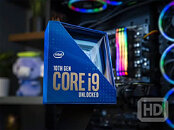
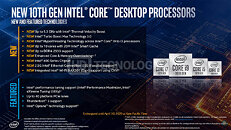

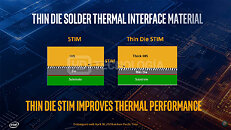
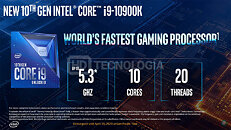
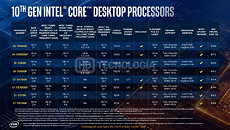
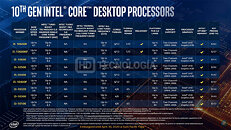
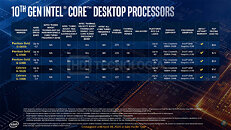
32 Comments on Intel 10th Generation Core Desktop Series Presentation Leaked
Thinner package makes for a more fragile CPU.
Embargoed until April 30th 6am.Package is the same size.
You are right!
They are just removing material from the die.
Doh!
Will have to be extra careful not to put too much pressure on it tho!
Intel, this is no longer 2015.
What a joke
They could have just printed in fat bold 'No Guarantees' across this whole part. Well, I guess the core count is true.
If the first was solid enough to take the pressure, then surely they could use that same height for the new one.
lol.
The 9900K was bad, because the heat was trapped inside the CPU-die and could not get out. Der 8auer stated to me peak heat transfer is around 240 to 260W for the 9900K. If you want more you need to delid and lap the cpu-die.
With the Z370 / 390 boards ignoring intel guidelines, pushing the cpu always to all core boost, you get a heat problem with heavy AVX2 load.
The TDP as usual is still as misleading since the likes of the flagship is likely going to need at least 2.5 to 3x the TDP when boosting. I am starting to dislike this "boost" marketing a lot because I feel both Intel and AMD are starting to abuse this, with Intel being the main culprit. For example, if they are claiming XX TDP, then they should be comparing performance at the base clock, and not an "up to 5.3Ghz" comparison. In cases like gaming, I feel if the cooling is sufficient, the CPU will certainly run above the base clock, and thus, drawing more than the advertised TDP by quite a large margin considering the base clock is quite low.
These Celerons have very low efficiency - 2C/2T @3.4GHz in 58-watt?!
Why don't we return to x87 while we are at it? We don't need those many SSE versions.